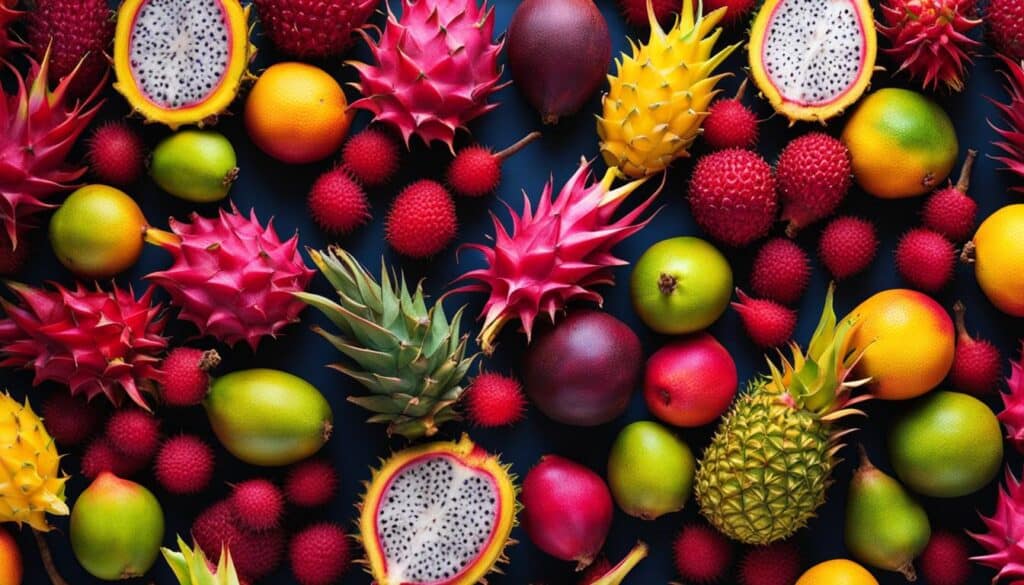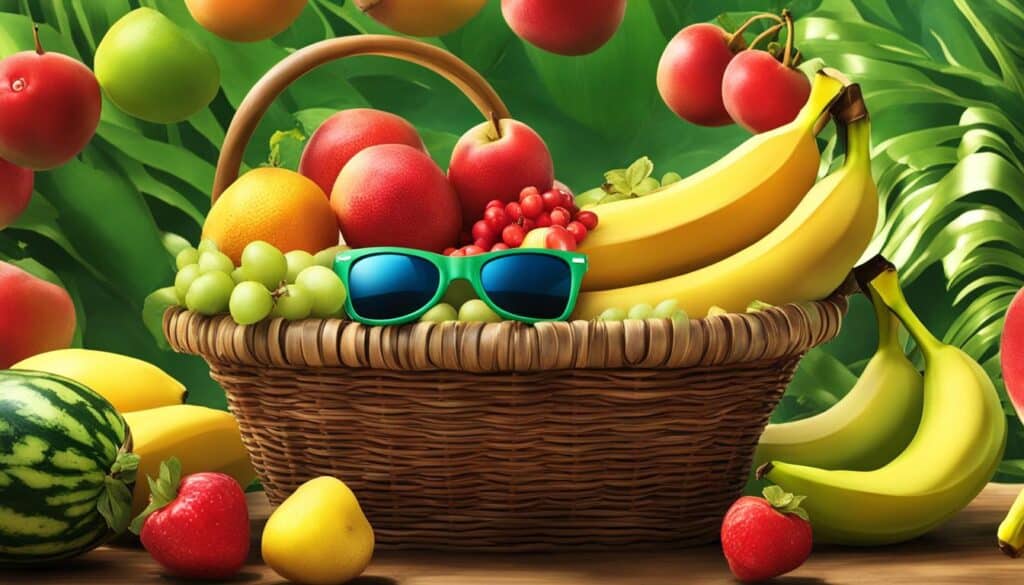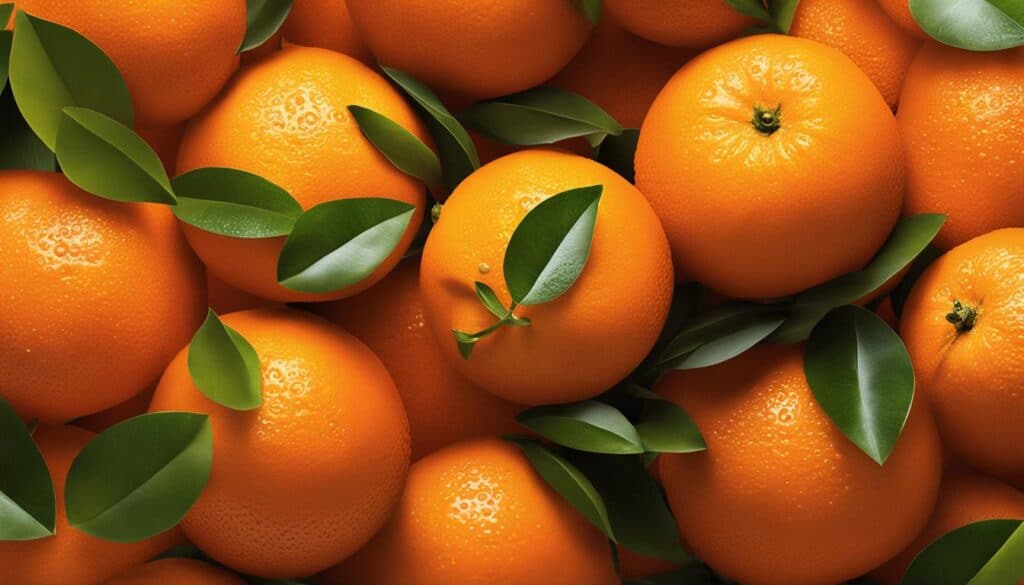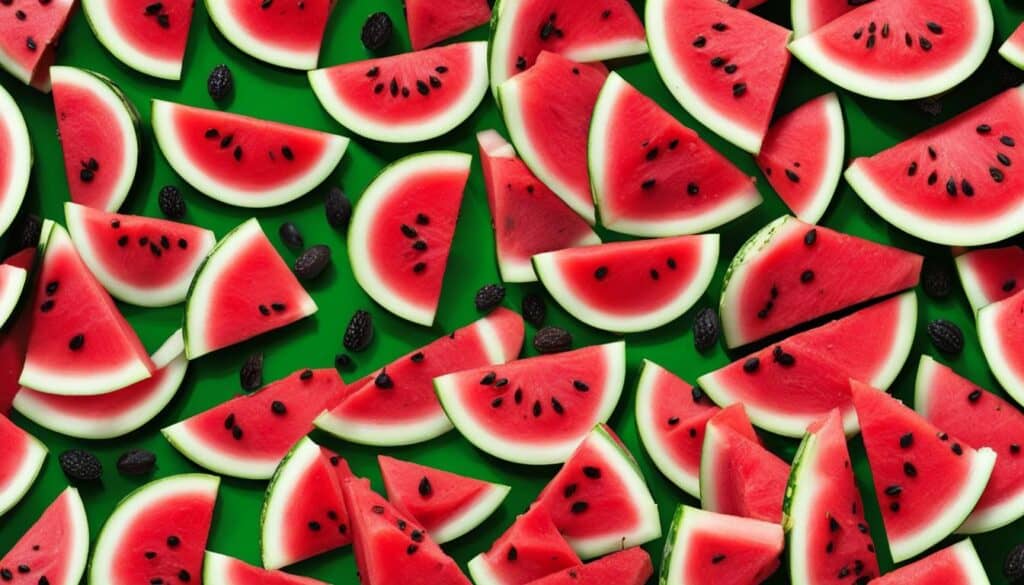Learning the names of different types of fruits is a great way to expand your English vocabulary. This comprehensive guide provides the English names of common fruits, along with descriptions and information on where they are commonly found. Fruits are a valuable source of nutrition and can be enjoyed in various forms.
Key Takeaways:
- Expand your English vocabulary by learning the names of different fruits.
- Fruits are a valuable source of nutrition and can be enjoyed in various forms.
- This guide provides English names, descriptions, and information on common fruits.
- Explore the vibrant world of fruits in the English language.
- Enhance your language skills with fun phrases incorporating fruit.
Learning Common Fruits
Fruits are not only delicious but also packed with essential nutrients. By familiarizing yourself with common fruits in English, you can expand your vocabulary and explore the diverse flavors and benefits they offer. Here are some popular fruits, their descriptions, and a glimpse into their nutritional value:
Apples
Apples are round fruits that come in different colors, such as red, green, and yellow. They have a crisp texture and a sweet-tart taste. Apples are a good source of fiber, vitamin C, and antioxidants, which contribute to overall health and well-being.
Bananas
Bananas are long, curved fruits with a creamy texture and a naturally sweet flavor. They are rich in potassium, vitamin C, and vitamin B6. Bananas are not only a convenient and portable snack but also a versatile ingredient in various recipes.
Oranges
Oranges are citrus fruits known for their refreshing taste and vibrant color. They are packed with vitamin C, which boosts the immune system and promotes healthy skin. Oranges are commonly consumed as a snack or used in juices and desserts.
| Fruit | Description | Nutritional Value |
|---|---|---|
| Apple | Round fruit with a variety of colors. Crisp texture and sweet-tart taste. | Good source of fiber, vitamin C, and antioxidants. |
| Banana | Long, curved fruit with a creamy texture and sweet flavor. | Rich in potassium, vitamin C, and vitamin B6. |
| Orange | Round citrus fruit with a refreshing taste and vibrant color. | High in vitamin C and promotes healthy skin. |
These are just a few examples of common fruits in English. By incorporating them into your diet, you can enjoy their delicious taste and reap the health benefits they offer. So go ahead and explore the world of fruits!
List of Exotic Fruits in English
When it comes to fruits, there’s a world beyond the usual apples and bananas. Exotic fruits add a touch of tropical flair to your palate, offering unique flavors and textures. Whether you’re an adventurous eater or simply looking to expand your fruit vocabulary, here’s a list of exotic fruits in English that you should try:
Mangosteen
The mangosteen is a small, purple fruit with a thick, leathery skin. Inside, you’ll find delicate white segments that offer a sweet and tangy flavor. Native to Southeast Asia, this fruit is often hailed as the “queen of fruits” due to its delicious taste and nutritional benefits.
Durian
The durian is known for its strong aroma, which some find overpowering. Despite its pungent smell, this spiky fruit has a creamy, custard-like texture and a unique combination of sweet and savory flavors. It’s a beloved fruit in Southeast Asia, and its distinct qualities make it a must-try for adventurous eaters.
Lychee
The lychee is a small, red fruit with a rough, textured skin. Peel away the skin to reveal a translucent, juicy flesh with a floral and sweet flavor. Native to China, lychees are now enjoyed worldwide and are often used in desserts and refreshing beverages.
Dragon Fruit
The dragon fruit, also known as pitaya, is a visually stunning fruit with vibrant pink or yellow skin and green scales. Inside, you’ll find a white or pink flesh speckled with tiny black seeds. This fruit has a mildly sweet flavor and is filled with vitamins and antioxidants.
These are just a few examples of the many exotic fruits waiting to be discovered. Whether you’re looking to add a tropical touch to your fruit bowl or want to explore new flavors, these unique fruits are sure to delight your taste buds.

10 Meals With Fruit in Them
Fruits are not only delicious on their own but can also be a fantastic addition to various meals. Incorporating fruits into your dishes can elevate their flavors, provide a burst of freshness, and add a touch of natural sweetness. Whether you’re looking for a healthy breakfast, a satisfying lunch, or a delightful dessert, here are ten mouth-watering meals that feature fruits.
1. Fruit Salad
A classic and refreshing option, fruit salad combines a delightful mix of fruits such as berries, pineapple, melons, and citrus. It’s a colorful and nutritious dish that can be enjoyed as a light breakfast or a refreshing side with any main meal.
2. Fruit Smoothie
Start your day off right with a delicious fruit smoothie. Blend together your favorite fruits, such as bananas, strawberries, and mangoes, with some yogurt or milk for a creamy and nutritious drink. You can also add a handful of spinach or kale for an extra boost of vitamins.
3. Fruit Pizza
Put a fruity twist on a classic favorite by making a fruit pizza. Spread a layer of cream cheese or yogurt on a sugar cookie or a pre-made pizza crust, then top it with a variety of sliced fruits like kiwi, berries, and mandarin oranges. It’s a delightful and visually appealing dessert that’s perfect for sharing.
4. Grilled Chicken with Mango Salsa
For a savory and fruity combination, try grilled chicken with mango salsa. Marinate the chicken in a tangy marinade, then grill it to perfection. Serve it with a refreshing salsa made from diced mangoes, onions, peppers, cilantro, and lime juice. The sweetness of the mangoes balances the smoky flavors of the chicken.
5. Spinach and Strawberry Salad
This vibrant salad combines the freshness of spinach with the sweetness of strawberries. Toss together baby spinach leaves, sliced strawberries, crumbled feta cheese, and some toasted nuts like walnuts or almonds. Drizzle it with a light vinaigrette dressing for a healthy and satisfying meal.
6. Tropical Chicken Skewers
Take your taste buds on a tropical adventure with these flavorful chicken skewers. Thread pieces of chicken, pineapple chunks, and bell peppers onto skewers, then grill or bake them until the chicken is cooked through. Serve with a side of rice or a fresh salad for a delicious and colorful meal.
7. Avocado and Mango Sushi Rolls
Experiment with fruit in your sushi by making avocado and mango rolls. Spread sushi rice on a sheet of nori, then add slices of avocado and mango. Roll it tightly and slice into bite-sized pieces. Serve with soy sauce, pickled ginger, and wasabi for a delightful twist on traditional sushi.
8. Peach and Chicken Salad
Combine juicy peaches with grilled chicken for a delicious salad. Toss together mixed greens, sliced peaches, grilled chicken, crumbled goat cheese, and some toasted pecans. Drizzle it with a tangy dressing like balsamic vinaigrette for a satisfying and flavorful meal.
9. Fruit Stuffed French Toast
Elevate your breakfast with fruit-stuffed French toast. Fill slices of brioche or French bread with a mixture of cream cheese and your favorite fruits, such as blueberries, raspberries, or sliced bananas. Dip the stuffed bread in an egg and milk mixture, then cook until golden brown. Serve with a dusting of powdered sugar and a drizzle of maple syrup.
10. Berry Crumble
End your meal on a sweet note with a delicious berry crumble. Combine your favorite berries, such as strawberries, blueberries, and raspberries, with a touch of sugar and a squeeze of lemon juice. Top it with a crumbly mixture of oats, flour, butter, and brown sugar. Bake until the berries are bubbling and the topping is golden brown. Serve warm with a scoop of vanilla ice cream.
These ten meals showcase the versatility of fruits and how they can add a delightful twist to your everyday dishes. Whether you’re looking for a light and refreshing salad, a fruity dessert, or a savory main course, these meals will satisfy your cravings and leave you wanting more.
Fun English Phrases About Fruits
Fruits have become more than just a part of our diet; they have also made their way into our language as metaphors, idioms, and expressions. These fun English phrases about fruits add color and creativity to our conversations. Let’s explore some common fruit phrases that you can use to spice up your language skills:
Pear-shaped
The phrase “pear-shaped” is often used to describe situations or plans that have gone wrong or turned out badly. Just like a pear, which has a rounded bottom and a narrower top, this phrase refers to situations that have taken an unexpected and undesirable turn.
Full of beans
If someone is “full of beans,” it means they are full of energy, lively, and enthusiastic. This phrase originated from the idea that beans, known for their high protein content, could provide a source of energy and vitality.
Cherry on top
When something is referred to as the “cherry on top,” it means it’s the final touch or the extra something that makes it even better. This phrase comes from the practice of adding a cherry as a decorative finishing touch to sweet treats like cakes and ice creams.
“An apple a day keeps the doctor away.” – Proverb
This popular proverb suggests that eating apples regularly promotes good health and can help prevent illnesses. While it may not guarantee complete immunity, apples are indeed a nutritious fruit packed with vitamins and fiber.
These fruit phrases, with their unique imagery and playful language, make communication more vibrant and expressive. So go ahead and sprinkle these fruit-related idioms into your conversations, and let the fruits of your linguistic creativity flourish!

Apple
Apples are one of the most popular and widely consumed fruits in the world. They come in various colors, including red, green, and yellow, and have a round shape with a firm texture. The taste of apples can range from sweet to slightly tart, depending on the variety. Some popular apple varieties include Red Delicious, Granny Smith, and Gala.
Apples are not only delicious but also nutritious. They are a great source of fiber, which helps in digestion and promotes a healthy gut. They also contain essential vitamins and minerals, such as vitamin C, potassium, and antioxidants that support overall health and boost the immune system.
Here is a table summarizing some of the popular apple varieties and their key characteristics:
| Apple Variety | Color | Taste | Texture |
|---|---|---|---|
| Red Delicious | Red | Sweet | Crisp |
| Granny Smith | Green | Tart | Firm |
| Gala | Red and yellow stripes | Sweet | Juicy |

Incorporating apples into your diet is easy and versatile. They can be enjoyed on their own as a healthy snack, added to salads for a crunch, baked into pies and desserts, or even used to make fresh apple juice. So next time you reach for a snack, consider grabbing an apple to satisfy your cravings while benefiting from its nutritional value.
Apple Nutrition Facts
- Rich in fiber, promoting healthy digestion
- Contains vitamin C and antioxidants, supporting immune health
- Good source of potassium, which aids in maintaining a healthy blood pressure
Banana
The banana is a popular fruit known for its distinctive shape, yellow peel, and sweet flavor. It is a versatile fruit that can be enjoyed on its own, added to smoothies, used in baking, or paired with other ingredients in various dishes. Bananas are not only delicious but also packed with essential nutrients, making them a healthy choice for snacking or incorporating into meals.
There are several varieties of bananas, each with its own unique characteristics. The most common variety is the Cavendish banana, which is widely available and has a creamy, slightly sweet taste. Other varieties include the plantain, which is larger and less sweet, and the red banana, which has a reddish peel and a sweet, tangy flavor.
Bananas are rich in potassium, vitamin C, and dietary fiber. They provide instant energy and are a great source of antioxidants. Additionally, bananas contain serotonin, a chemical that can boost mood and help regulate sleep patterns. This makes them a perfect snack for those looking for a quick energy boost or a natural remedy for stress and anxiety.
Whether enjoyed as a quick and easy snack or incorporated into your favorite recipes, bananas are a versatile fruit that offers both taste and nutrition. So next time you’re at the grocery store, don’t forget to grab a bunch of bananas to enjoy throughout the week.
Health Benefits of Bananas
- Rich source of potassium, which is essential for heart health and maintaining proper blood pressure levels.
- Contains vitamin C, which supports a healthy immune system and promotes collagen production.
- Good source of dietary fiber, aiding in digestion and promoting a feeling of fullness.
- Packed with antioxidants, which help protect the body against free radicals and oxidative stress.
- Natural source of serotonin, a neurotransmitter that helps regulate mood and promote feelings of well-being.
Orange
Oranges are vibrant citrus fruits with a sweet-tart flavor that is both refreshing and invigorating. They are one of the most popular fruits in the world, known for their bright orange color and juicy segments. Oranges are rich in vitamin C, providing a boost to the immune system, and they also contain dietary fiber, which aids digestion.
There are several varieties of oranges, each with its own unique characteristics. The most common varieties include:
- Navel oranges: Known for their seedless nature and easy-to-peel skin, navel oranges are sweet and juicy.
- Blood oranges: These oranges have a distinct red flesh and a flavor that is slightly sweeter and more floral than other varieties.
- Cara cara oranges: With a pinkish-red flesh and a taste reminiscent of berries, cara cara oranges are a delightful and unique variety.
Whether enjoyed fresh, juiced, or used in culinary creations, oranges are a versatile fruit that adds a burst of flavor to any dish. From salads and desserts to marinades and drinks, the possibilities are endless when it comes to incorporating oranges into your favorite recipes.

| Orange Variety | Description | Nutritional Benefits |
|---|---|---|
| Navel Orange | Seedless with easy-to-peel skin, sweet and juicy | High in vitamin C, dietary fiber |
| Blood Orange | Distinct red flesh, slightly sweeter and more floral flavor | Rich in vitamin C, antioxidants |
| Cara Cara Orange | Pinkish-red flesh, taste reminiscent of berries | Good source of vitamin C, fiber |
Strawberry
Strawberries are small, red fruits with a sweet flavor. They are widely loved for their juicy texture and vibrant color. As a member of the rose family, strawberries are packed with essential vitamins and minerals that contribute to overall health and well-being.
There are several varieties of strawberries, each with its own unique characteristics. Some popular varieties include:
- Albion: Known for its large size and intense flavor.
- Chandler: A sweet and juicy strawberry with a bright red color.
- Seascape: This variety is known for its excellent shelf life and firm texture.
Strawberries are a nutritional powerhouse. They are rich in vitamin C, antioxidants, and dietary fiber. These nutrients contribute to a healthy immune system, support cardiovascular health, and aid in digestion. Including strawberries in your diet can provide numerous health benefits.
| Nutrient | Amount per 100g |
|---|---|
| Calories | 32 |
| Protein | 0.7g |
| Carbohydrates | 7.7g |
| Fiber | 2g |
| Vitamin C | 58.8mg |
| Calcium | 16mg |
| Potassium | 153mg |
Strawberries can be enjoyed in a variety of ways. They are delicious on their own, added to salads, blended into smoothies, or used to enhance the flavor of desserts. When selecting strawberries, choose ones that are plump, firm, and brightly colored. Avoid strawberries that are mushy or have mold. By incorporating strawberries into your diet, you can savor their delightful taste while reaping the numerous health benefits they offer.
Watermelon
A favorite summer fruit, watermelon is known for its refreshing taste and vibrant red color. This juicy fruit is not only delicious but also packed with nutrients that benefit your health. Let’s explore the different varieties, unique characteristics, and nutritional benefits of watermelon.
Varieties of Watermelon
Watermelons come in various shapes, sizes, and colors, offering a range of choices for fruit lovers. Some popular varieties include:
- Seedless Watermelon: This variety is perfect if you prefer fewer seeds and a sweeter taste.
- Yellow Watermelon: With a bright yellow flesh, this variety has a slightly milder flavor compared to traditional red watermelon.
- Sugar Baby Watermelon: These small-sized watermelons are known for their intense sweetness and crisp texture.
Nutritional Benefits of Watermelon
Watermelon is not only a tasty treat but also a nutritious addition to your diet. It is a rich source of vitamins A and C, which help support a healthy immune system and promote overall wellbeing. Additionally, watermelon is hydrating due to its high water content, making it a great choice for staying refreshed during hot summer days.
| Nutrient | Amount per 100g |
|---|---|
| Calories | 30 |
| Carbohydrates | 8g |
| Fiber | 0.6g |
| Vitamin A | 21% of the Daily Value (DV) |
| Vitamin C | 18% of the DV |
Enjoy watermelon on its own as a refreshing snack, or incorporate it into salads, smoothies, or even grilled dishes for a burst of natural sweetness. Its versatility and nutritional value make it a fantastic addition to any summer menu.

Conclusion
Expanding your vocabulary to include the names of fruits in English is a valuable endeavor that can greatly enhance your language skills. With this comprehensive guide, you’ve gained knowledge about common and exotic fruits, their descriptions, nutritional benefits, and even fun phrases that incorporate fruit.
By incorporating fruits into your language learning, you not only improve your vocabulary, but you also gain insights into the vibrant world of fruits and their significance in various cultures. Fruits are not only delicious and nutritious, but they also provide a rich source of inspiration for language and expression.
So, whether you’re exploring the crispness of an apple, the creaminess of a banana, the tanginess of an orange, the sweetness of a strawberry, or the juiciness of a watermelon, incorporating these words into your vocabulary repertoire will open up a world of possibilities for effective communication and language fluency.
FAQ
What are some common fruits in English?
Common fruits in English include apples, bananas, oranges, strawberries, and watermelons.
What information is provided about each fruit?
For each fruit, we provide descriptions of their appearance, taste, and nutritional benefits.
Are there any exotic fruits included in the guide?
Yes, the guide includes a list of exotic fruits such as mangosteen, durian, lychee, and dragon fruit.
Are there any meal ideas that include fruit?
Yes, the guide offers 10 meal ideas that incorporate fruits, such as fruit salad, fruit smoothies, fruit pizza, and fruit pie.
Are there any fun English phrases about fruits?
Yes, the guide includes a collection of fun English phrases that incorporate fruit, adding colorful expressions to your language repertoire.
What information is provided about apples?
The guide provides information on different apple varieties, their appearance, taste, and nutritional benefits.
What information is provided about bananas?
The guide covers different banana varieties, offering details on their appearance, taste, and nutritional value.
What information is provided about oranges?
The guide highlights various orange varieties, describing their appearance, taste, and nutritional benefits.
What information is provided about strawberries?
The guide focuses on different strawberry varieties, providing information on their appearance, taste, and nutritional value.
What information is provided about watermelons?
The guide provides details about various watermelon varieties, their appearance, flavor, and nutritional benefits.





Leave a Reply